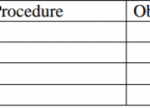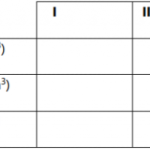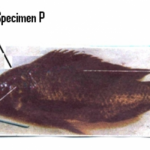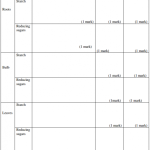KNEC KCSE Biology Paper 3 Question Paper / 2015 KCSE Kericho West Joint Examination
2015 KCSE Kericho West Joint Examination
Biology Paper 3
You are provided with the following solutions labelled E, F, G, H and J on the table.
E – food substance
F – dilute sodium hydrogen carbonate
G – dilute hydrochloric acid
H – Benedict’s solution.
Source of heat.
Carry out tests using the reagents provided to determine the food substance(s) presented in solution E (14 marks)
FOOD SUBSTANCE BEING TESTED PROCEDURE OBSERVATIONS CONCLUSION
14 marks
Examine the photograph which shows parts of the urogenital system of a female rat and answer the questions that follow. The organ marked 1 is the stomach.
a) i) Name the organ marked 2 ……………………………………………………………………………………. (1 mark)
ii) State two functions of the organ. (2 marks)
iii) What is the functional unit of the organ named in (a) (i) above? (1 mark)
b) i) Identify and name each of the organs marked 3 and 4. (2 marks)
ii) State two functions of the part marked 4. (2 marks)
c) i) Identify and name the organ marked 5. (2 marks)
ii) Explain two functions of the organ named c(i) above. (2 marks)
d) The organ marked 6 is the large intestine. State two functions of the large intestine. (2 marks)
14 marks
Study the photographs A and B that shows part of plants in natural habitat.
a) Name the type of the plant response shown in:
i) A…………………………………………………………………………………………………………………(1 mark)
ii) B…………………………………………………………………………………………………………………(1 mark)
b) Explain the mechanisms of the response in
A (3 marks)
B (5 marks)
c) State the biological significance of the response to plants in
A (1 mark)
B (1 mark)
d) Suggest the nature of the habitat that plants with the type of response A grows. (1 mark)
14 marks
BIOLOGY PAPER 3 MARKING SCHEME
2015 KCSE Kericho West Joint Examination
Biology Paper 3
Procedure – 2 marks each for non-reducing sugar and ascorbic a cid and 1mark for reducing sugar.
Observation – 1 mark each
Conclusion – 1 mark each
Total = 12 marks
NB- When the procedure is wrong, no mark for observation and conclusion.
14 marks
a) i) Kidney;
ii) Osmoregulation;
Excretion;
iii) Nephron;
b) i) 3 funnel ;
4 ovary;
ii) site for production of ova / female gametes / secondary oocytes.;
Secretion of hormones ;
c) i) Uterus;
ii) Site for implantation;
Nourishment and development of foetus.;
d) Site for absorption of water;
Site for absorption of vitamins and mineral salts.;
Propulsion of food down the alimentary canal ; (any two points)
14 marks
a) A Nastic response / haptonasty;
B Thigmotropism;
b) A
− The plant secrets sugary secretions that attract insects.
− Insect touch is sensitive / triggers hairs in the leaves / midrib. The midrib cells lose water by osmosis; the midrip
becomes flaccid causing the trap to spring and thus trap insects due to interlocking of the spines.
B
− At the point of contact, Auxins /IAA to migrate to side away from contact; reaching to a higher auxins concentration
at point away from contact than at point of contact.
− High auxin concentration stimulate shoot growth thus side away from contact grows faster than the side in contact;
leading to continuous coiling of the shoot / tendrils along support material.;
c) A
– Enables feeding in insectivorous plant.
B
– Enables shoots of herbaceous plants to obtain support to expose leaves for photosynthesis; flower for pollination
fruits and seeds for dispersal.;
d) Nitrogen deficient soil / marshy areas.;
14 marks







